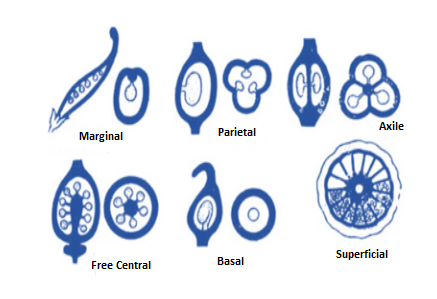
Explain different types of placentation in detail.
Answer
334.8k+ views
Hint: Placentation refers to how the ovules and developing seeds are fixed to the plant's ovary. Every single developing seed will fix with the ovary wall or a central structure in the ovary. A filament of plant tissue is defined as the funiculus that attaches the seed to the ovary wall.
Complete step-by-step answer:
Placentation indicates the structure, kind, formation and or arrangement of placentas. The area of the ovary wall in which the ovules are connected in a flower is known as the placenta. Several kinds of placentations found in flowering plants are
Marginal placentation: The placenta creates a ridge along through the ventral suture of the ovary, ovules are borne on the ridge to form two rows. Example: Pea
Axile placentation: The placenta is axial, and ovules are connected to it in a multilocular ovary. Example: Lemon
Parietal placentation: Ovules evolve on the peripheral or on the inner wall of the ovary. It is single-chambered, but because of the development of a false septum, it turns into two-chambered. Example: Mustard
Basal placentation: The placenta evolves at the base of the ovary in which a single ovule is connected to it. Example: Marigold
Free central placentation:On the middle axis ovules are borne and septa are not present. Example: Primrose

Image: Types of placentation
Note: Placentation is the layout of ovules in the ovary of a plant. The function of placentation is to transmit respiratory gases, nutrients, and water from maternal tissue to a growing embryo, and in certain cases to eliminate waste from the embryo.
Complete step-by-step answer:
Placentation indicates the structure, kind, formation and or arrangement of placentas. The area of the ovary wall in which the ovules are connected in a flower is known as the placenta. Several kinds of placentations found in flowering plants are
Marginal placentation: The placenta creates a ridge along through the ventral suture of the ovary, ovules are borne on the ridge to form two rows. Example: Pea
Axile placentation: The placenta is axial, and ovules are connected to it in a multilocular ovary. Example: Lemon
Parietal placentation: Ovules evolve on the peripheral or on the inner wall of the ovary. It is single-chambered, but because of the development of a false septum, it turns into two-chambered. Example: Mustard
Basal placentation: The placenta evolves at the base of the ovary in which a single ovule is connected to it. Example: Marigold
Free central placentation:On the middle axis ovules are borne and septa are not present. Example: Primrose

Image: Types of placentation
Note: Placentation is the layout of ovules in the ovary of a plant. The function of placentation is to transmit respiratory gases, nutrients, and water from maternal tissue to a growing embryo, and in certain cases to eliminate waste from the embryo.
Recently Updated Pages
What is glandular epithelium class 11 biology NEET_UG

The common characteristics between tomato and potato class 11 biology NEET_UG

Why are manures considered better than fertilizers class 11 biology CBSE

Find the coordinates of the midpoint of the line segment class 11 maths CBSE

Distinguish between static friction limiting friction class 11 physics CBSE

The Chairman of the constituent Assembly was A Jawaharlal class 11 social science CBSE

Trending doubts
What is BLO What is the full form of BLO class 8 social science CBSE

What is meant by exothermic and endothermic reactions class 11 chemistry CBSE

Which places in India experience sunrise first and class 9 social science CBSE

What are the major means of transport Explain each class 12 social science CBSE

Which are the Top 10 Largest Countries of the World?

Fill the blanks with the suitable prepositions 1 The class 9 english CBSE




